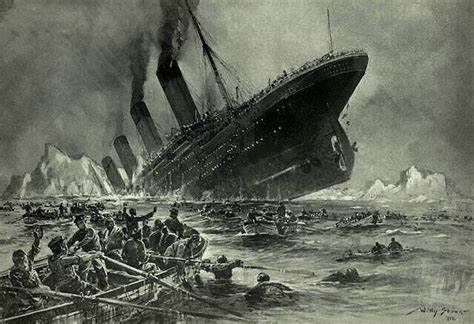Dispatches from Home: Titanic – The Old Curiosity Shop.

Like Dickens’ old curiosity shop, my little house is a repository of battered antiques, ruined finery, and dusty memories. Because less is best in interior design these days, when I shuffle off this mortal coil, my treasures may bring a buck-fifty at a garage sale. (Big Smile!) However, my collection of Titanic memorabilia might bring a wee bit more.
For over fifty years, I’ve collected books…lots of books…about the Titanic and purchased a few exciting goodies of some value. One is a framed picture of the Titanic, bought in a Montreal antique shop almost thirty-five years ago. I paid forty dollars for it and held it in my lap on the flight back to Gulfport. I’d seen the vintage picture in one of my books but could not remember which one.
Years later, while surfing the internet, I found the picture. It was the Tichnor Brothers Publishing Company’s memorial picture of the lost liner, which sold for a dollar in 1912. (Astute observers will note that the ship is the Titanic’s sister, Olympic. Can you tell?)
Framing the old picture was a labor of love, a somewhat crude one at that. Whoever created the frame did so from old molding; its backing is rough wooden slats. The frame’s wavy glass is plate-glass, very heavy. In a flowing script, written in French on yellowing ledger paper, someone wrote about the sinking, listing the place and date, details about the great liner’s interiors, and the number of passengers and survivors. Some of the information is incorrect, which makes the picture all the more enjoyable. There is no indication who framed the picture, but whoever did so must have been somewhat bereft of funds—the matting is old-fashioned green blotter paper.
The Titanic’s sinking affected people’s sense of contentment. It was not just another disaster. It was a wake-up call against human arrogance and is now a metaphor for overconfidence in man’s technology. The sinking signified the end of the liner and the end of the age that made it possible.
Jack Thayer, seventeen in 1912, recalled in 1940 what life was like before the Titanic sank: “There was a peace in those days, and the world had an even tenor to its ways. It seems to me that the disaster was the event that not only made the world rub its eyes and awake but woke it with a start, keeping it moving at a rapidly accelerating pace ever since with less and less peace, satisfaction, and happiness. To my mind, the world of today awoke April 15th, 1912.” Sadly, four years after he wrote this, Jack committed suicide.
I’d like to think that whoever created his/her own little Titanic memorial found some contentment and peace in doing so.


